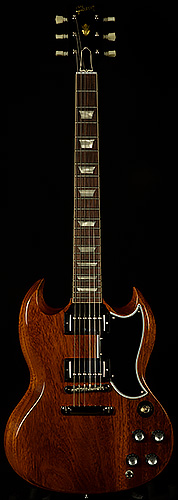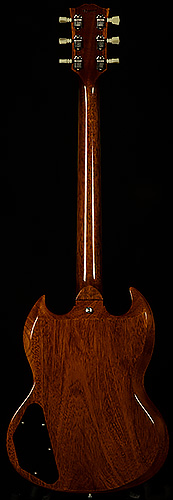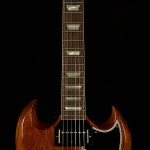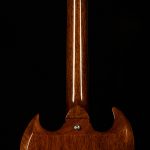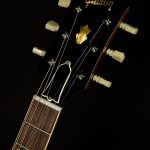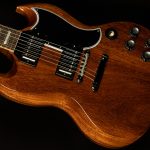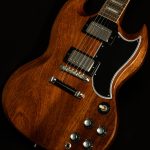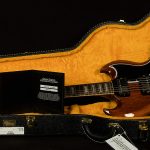Gibson Custom Shop Wildwood Spec 1964 SG Standard – Gloss, Maestro
The Wildwood Spec SG: A True Sonic Titan
If it weren't for the Gibson SG, I sincerely doubt I'd be sitting here writing words for all you lovely people of the Wildwoodiverse to read about our Wildwood Spec SGs. Like many guitar nerds, I had no choice but to give my life to rock and roll after I heard the proverbial One Guitar; in my case, it was Angus Young's SG. Once my dad played me Back in Black when I was six, it was all over. It probably had something to do with the riffs (AC/DC does know a thing or two about songwriting), but the SG's tone and appearance have always spoken to me on an elemental level.
Though it has plenty of muscle, it sounds less like a bodybuilder and more like a scary dude in a leather jacket picking his teeth with a switchblade. And, it has a sensitive side. Though there's an exciting rawness and attitude to the SG's sound, it never loses its inherent woody warmth. It may be raw, but it has plenty of range. So, in Tommy Iommi's hands, the SG snarls like a hellhound. In Derek Trucks's hands, the SG cries like a female blues singer from the Delta circa 1927. What's the common thread? Both players aim to bottle raw, intense emotion with their playing, and the SG is the perfect instrument for the job.
Because the SG wears its heart on its horns, it’s a guitar that I love deeply, and the Wildwood Spec version is my personal favorite example of the model. We’ll get to tech specs later, but I want to help you understand the deeper reasons why Wildwood Spec SGs are such wonderful instruments, the ones that go beyond fret size and pickup output. The SG is so deeply intertwined with my life and my musical journey that I need to tell part of my own story to properly tell the story of the Wildwood Spec SG. If you just want to hear about the nuts and bolts of these mahogany-bodied monsters, feel free to skip ahead to the second-to-last header. But, it’s a compelling story—I promise.
My Solid Guitar Story
The SG seems to pull raw, unadulterated, pure music out of people, and that’s why I bought one before I moved to Colorado four years ago. At that point, I had mostly given up on music after joint problems made playing nearly impossible. Though my body had recovered, the creative spark was gone. I still loved listening to music, but I didn't really feel any desire to play. I had read a biography of jazz saxophonist Sonny Rollins, and one of his favorite pieces of advice for aspiring musicians stuck with me: if you don't hear music in your head, don't pick up your instrument. That seemed reasonable to me, and since I didn’t hear anything, I stopped playing. Better to sit in silence than hear myself going through the motions.
Of course, I missed playing the guitar, but it was a peculiar sort of ache, like an amputee pining for a phantom limb. From time to time, I’d pull my guitar out of the case to see if the magic came back, but it never did. I never stopped wanting it to return, though.
So, before I left home for Denver, I decided to make one last effort to summon that spark of creative energy. I figured that if I got myself an awesome guitar, it might at least inspire me to noodle more, and if I noodled more, maybe I’d start to hear notes in my head again. After roughly 2.5 seconds’ worth of consideration, I knew the guitar had to be an SG. I had some practical reasons (they’re versatile enough to excel in just about any genre, they’re lightweight, the neck is comfortable) and some not-so-practical (it has horns, and pointy guitars are cool). But mostly, I was hoping that the SG’s raw, direct personality would pull some music out of me.
It didn’t happen overnight. I decided to learn every Black Sabbath riff in chronological order starting with the eponymous track on their self-titled first record. At first, it was a workmanlike endeavor. I put my fingers where they were supposed to be, and the correct sounds came out of my amplifier at the right times.
But, as I worked my way through more tunes on that Pelham Blue SG, I began to remember the elemental joy of making music again. I could feel the guitar pulling the visceral rock and roll energy out of me like a mahogany magnet as I ran through tunes like Into the Void and Behind the Wall of Sleep. By the time I finished up Masters of Reality, I decided to bring my grand quest for ultimate Sabbathian scholarship to a premature end because I was having more fun coming up with my own heavy riffage.
After a few months of basement jamming, I realized that it was silly to keep my SG all to myself. So, I started jamming with people for the first time in years. Those jams quickly turned into band practices, and there was no looking back. I was playing constantly. Though I’ve since moved back to my first love, bass guitar (and everyone who ever heard me play guitar uttered a collective sigh of relief when I did so), the music has returned to my brain. When I’m not writing about guitars for Wildwood, I’m at band practice. I play in three bands, and I keep threatening to start a fourth.
Would all of this have happened if I had gotten, say, a Telecaster instead of an SG? Almost certainly, because things don’t change you—you change you. I went looking for the music in my head, and that’s why I found it. But, things like guitars can be useful tools on journeys through the dark parts of life. I simply chose the SG as my tool. SGs have had a sympathetic resonance with my heartstrings ever since.
Love at First Strum
How perfect would it be if the tool I’m talking about was a Wildwood Spec SG? Alas, life isn’t a movie. I didn’t play a Wildwood Spec SG until three years after my move when I started working at Wildwood. I distinctly remember plugging in a VOS model with a natural finish, playing a few doodles around the ninth fret with the open A string ringing, and immediately getting choked up.
That might seem like a strange response to a couple licks in A major, but (as I’ve spent the last thousand words telling you) SGs are special to me, and the sounds coming out of the speaker cone at that moment were such a perfect example of the tone that has inspired me for my whole musical life that my emotions overcame me for a moment. It was like stepping into one of my favorite records in real time. For someone who loves Gibson SGs as much as I do, playing a Wildwood Spec edition is truly a magical experience.
When I did a write-up on that guitar for the website, I believe I said that it was “the platonic ideal of an SG.” Since then, dozens of Wildwood Spec SGs have passed through my hands, and I am pleased to say that my initial impression is still correct. Though each guitar has had a distinctive personality, they all sounded iconic in their own way and played like butter.
The Source of the Sonic Sauce
So, why do so many inspiring sounds come out of Wildwood Spec SGs so consistently? The answer is rather simple: the wizards and warlocks at the Gibson Custom Shop find the best raw materials they can and assemble them with incredible skill, care, and precision. They start with a resonant slab of mahogany, which automatically gives the guitar a woody, warm, midrange-forward voice while also enhancing responsiveness. Then, they attach a mahogany neck to the body using hide glue.
Making instruments with hide glue is an old-world manufacturing process that requires incredible skill and patience, but it pays incredible dividends for the instrument’s voice. Because it’s a protein-based adhesive, it promotes the greatest possible amount of energy transfer between pieces of wood. That gives the guitar excellent resonance and sustain. After slapping on a sweet-sounding rosewood fretboard with more hide glue, the skeleton is complete.
To complete the package, our friends drop in a couple Wildwood Spec Custombuckers, which sound magnificent. Gibson based them off some of our favorite old PAFs, and they did a bang-up job of recreating that fabled vintage magic. The highs sing, the mids are punchy, and the lows are warm and woody, and overall they are quite dynamic and expressive.
The Wildwood Spec SG is a simple guitar built to perfection by some of the most skilled craftsmen in the world, and that’s why they sound good enough to make a grown man get emotional in the middle of a loud, frenetic guitar store. The entire Wildwood team is proud to showcase them for all you Wildwoodians traversing the Wildwoodiverse, and I hope they bring you as much joy as they bring me.
Specifications:
| Brand | Gibson Custom Shop |
|---|
| Model | Wildwood Spec 1964 SG Standard |
|---|---|
| Finish Color | Faded Cherry Red |
| Finish Type | Gloss |
| Limited Series | 6.54 lbs. |
| Body Wood | 1-Piece Solid Mahogany |
| Neck Wood | Solid Mahogany |
| Neck Joint | Hot Hide Glue |
| Neck Shape | Authentic '64 Medium C-Shape |
| Neck Dimensions | .870 1st - .980 12th |
| Fingerboard | Rosewood Attached with Hot Hide Glue |
| Inlays | Cellulose Nitrate Trapezoid |
| Scale Length | 24.75" |
| Width at Nut | 1.69" |
| Nut Material | Nylon |
| Frets | 22 Authentic Medium Jumbo |
| Pickups | 2 Wildwood Spec Custombuckers |
| Controls | 2 Volume, 2 Tone, 3-Way Selector Switch |
| Hardware | Nickel |
| Tuners | Kluson Single Line Double Ring |
| Bridge | ABR-1 |
| Tailpiece | Maestro Vibrola |
| Case | Gibson Custom Shop Black/Yellow Hardshell with Wildwood Spec Badge |
| COA | Yes |
Why Order from Wildwood Guitars?
An instrument from Wildwood isn't just an ordinary guitar. It's your guitar. Each and every instrument we sell includes a full, point by point setup, an exhaustive evaluation, and expert shipping procedures, with first class, industry leading standards from start to finish. Why? Because you deserve it.Click Here to learn more about what makes a Wildwood instrument so special...



